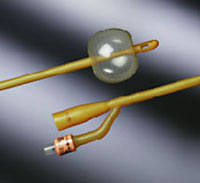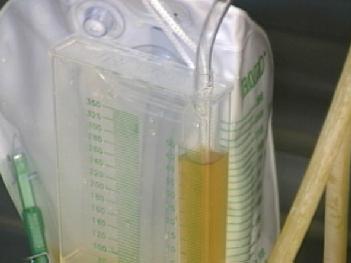|
CATHETER; A catheter is a tube that is inserted into the body. Catheters can be inserted into any vessel or cavity. They can also be inserted through puncture wounds to drain fluid collections. Although catheters can be used for many different reasons, you may hear the word "Foley Catheter" or "Bladder Catheter" used most frequently. A Foley catheter is a small tube that is inserted into the bladder to drain urine. A donut style balloon is inflated after the catheter is inserted into the bladder (Image 2). The balloon will prevent the catheter from following out. Some bladder catheters have a thermometer in the tip that allows us to use the catheter to drain urine and measure the patient's temperature closely. Sometimes we want to flush the bladder to clear blood or infection. We can use a special bladder catheter called a "3-way" catheter. This type of catheter has an extra lumen (or pathway) that allows us to administer a infusion of fluid into the bladder. The kidneys produce urine at a steady rate. The two kidneys drain urine into the bladder. Urine leaves the bladder through the urethra (Image 1). Any reduction in blood flow to the kidneys will cause a rapid decline in the rate that urine is produced. We measure urine output every hour in critically ill patients to help us to evaluate the adequacy of their cardiac output or heart function, to assess their fluid status, and to monitor kidney function (Image 2). Image 3: Foley catheter showing balloon inflated. |
Image 1: The two kidneys produce a constant flow of urine. Urine drains from each kidney through one of the two ureters. The ureters empty into the bladder, and the bladder empties through the single tube called the urethra. A bladder catheter is inserted into the urethra. |
|
Image 2: Hourly urine collection. |
|
|
|
|
|
|
|
|
|
Last Reviewed: October 23, 2014





